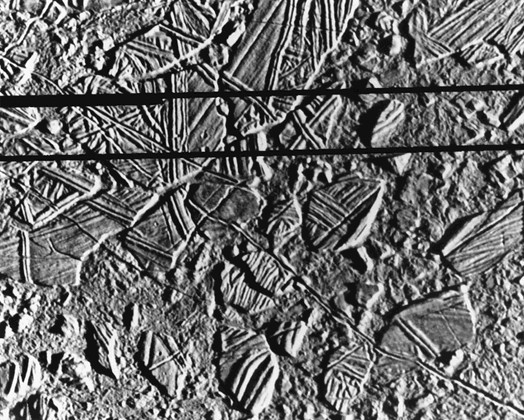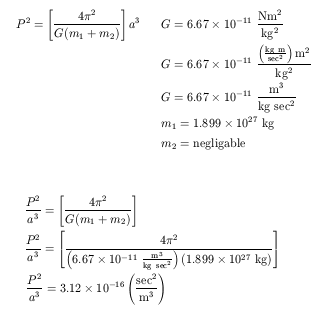From Chapter 17.
Question 1.
Discovery of asteroids
Astronomers were
looking for a planet between Mars and Jupiter and found many small objects
(diameters less than 500 km) orbiting the Sun. These are now called
asteroids or minor planets.
Question 2.
The asteriod belt.
Most asteriods have
orbits that lie within the plane of the ecliptic and at distances from
the between 2 and 3.5 AU. These are the "belt" asteroids. Several
asteroids, such as Apollo and Icarus have more elliptical and/or inclined
orbits.
Question 3.
Kirkwood gaps
Kirkwood gaps are
gaps in the distribution of asteroid orbital periods. These gaps
occur and simple fractions (e.g. 1/2, 1/3, etc) of Jupiter's orbital period.
Kirkwood gaps are caused by the gravitational interaction between Jupiter
and asteriods with these periods. The orbits of asteriods that fall
into the Kirkwood gaps are regularly disturbed every few orbits (2, 3,
etc.) The orbits are drawn into progressively more and more ellipitcal
shapes until they come close enough to Jupiter for Jupiter's gravitational
attraction to have more effect than the Sun's. At this point, the
asteroid is usually flung completely out of the solar system.
This same effect explains why Saturn's moon Mimas causes the Cassini division
in Saturn's rings.
Question 5.
The Trojan asteroids
The Trojan asteroids
are groups of asteroids that share Jupiter's orbit. One group orbits
ahead of Jupiter by 60 degrees, the other behind by 60 degrees. The
stability of these orbits are made possible by a symmetry between the gravity
of the Sun and Jupiter called Lagrange points. A similar arangement
is found in Saturn's moons Tethys, Calypso and Telesto.
From Chapter 13.
Question 2.
Jupiter's chemical composition compared to the Sun
The chemical compositions
of the Sun and Jupiter are very similar:
| Element | Sun | Jupiter |
| Hydrogen | 74% | 71% |
| Helium | 25% | 24% |
| Other | 1% | 5% |
This similarity suggests that the Sun and Jupiter formed from the same source of material (the solar nebula) and probably at the same time.
Question 3.
Jupiter's excess heat
Jupiter is large
enough so that it is probably still cooling down from its initial formation
5 billion years ago. This means its interior is still warm and heat
is continually leaking out.
Question 4.
Belts and zones
Belts and zones
are the dark and light bands (respectively) at the top of Jupiter's atmosphere.
They are formed by convection in the atmosphere (the lava lamp effect)
where belts are cool material that is sinking and zones are warmer material
that is rising. The Great Red Spot is more like a zone than a belt because
it is made up of warmer material that is rising up from below.
Question 5.
Jupiter is oblate
Jupiter is oblate
(its equitorial diameter is larger than its polar diameter) because Jupiter
is mostly a rotating ball of gas. As it rotates, the material at
the equator gets flung out by centrifugal acceleration with greater for
than the material at the poles. The amount of oblateness indicates
the size and density structure of the outer layers of the atmosphere.
Question 6.
Internal rotation
Jupiter's internal
rotation rate is probably about the same as the rotation rate of its magnetic
field, which is generated deep inside the planet.
From Chapter 14.
Question 1.
Compare and contrast Galilean satellites to Solar System
Jupiter's Galilean
satellites all appear to have formed at the same time as Jupiter, just
as the planets probably formed at about the same time as the Sun.
Our evidence for this is that the Galilean satellites all orbit roughly
in the plane of Jupiter's equator and their compositions and internal structure
are a function of distance away from Jupiter. The evidence indicates
that heat from Jupiter helped keep water and other light elements in vapor
form on Io and Europa, which is why they are somewhat more dense than Ganymede
and Callisto. On the other hand, Io, the innermost Gallilean satelllite
is very geologically active because of tidal heating and heating from Jupiter's
strong magnetic field. Mercury, the innermost planet, on the other
hand, is geologically dead: it is too small to have retained its heat of
formation and it does not generate much internal heat from tital interactions
with the Sun.
Question 2.
Source of energy for Io's volcanos.
Io's volcanos are
powered by heat that is generated from within Io. Where does this
heat come from? Most of it probably comes from tidal forces; some
might be caused by Jupiter's strong magnetic field. Io's orbit it
distorted by its periodic proximity to Europa and Ganymede. The resulting
elliptical orbit brings Io closer to and farther away from Jupiter, which
changes the internal stresses on Io, resulting in frictional heating.
Question 5.
The Io torus
The Io torus is
a doughut-shaped cloud of plasma (super hot gas) that is locked into
Jupiter's magnetic field by the interaction of the charged particals and
the magnetic field. The material in the torus is probably volcanicly
ejected from Io, which would explain why the torus is close to Io's orbit.
Question 9.
Evidence of liquid water under Europa's surface.
First of all, the
surface of Europa is mostly ice. The picture below shows that
there is something under this ice that is either soft and slippery or all
together liquid. Pieces of the ice surface have clearly broken apart
from eachother and floated or slipped to new positions. New
material has frozen in between the

Question 10.
Life on Europa?
Europa may have
liquid water, an ingredient essential for life as we know it.
Question 11.
Ganymede's magnetic field
Magnetic field is
generated by moving charges. Since Ganymede has a magnetic field,
that means there must be charges moving inside of it, which implies some
sort of liquid. However, Ganymede's current orbit is too far from
Jupiter to have enough tidal heating to keep its interior warm enough to
support liquid. One possibility is that Ganymede previously had a
more ellipitical orbit that brought it closer to Jupiter, where tidal heating
is greater. Then something happened to circularize Ganymede's orbit
and it has yet to cool off.
Question 20. Kepler's 3rd law
Let's make a table with the book's P and a values and then calculate P2/a3 for all of the satellites. This should work out to be the quantity in the square brakets in all cases:

| Moon | P (days) | P (seconds) | a (km) | a (m) | P2/a3 (sec2/m3) |
| Io | 1.769 | 152840 | 421600 | 4.216 x 108 | 3.12 x 10-16 |
| Europa | 3.551 | 306810 | 670900 | 6.709 x 108 | 3.12 x 10-16 |
| Ganymede | 7.155 | 618190 | 1.070 x 106 | 1.070 x 109 | 3.12 x 10-16 |
| Callisto | 16.689 | 1441900 | 1.883 x 106 | 1.883 x 109 | 3.11 x 10-16 |